Page 4 - Performance Tests
For the tests, the ASUS ROG Strix GS-AX5400 wireless router was placed on the main floor of my colleague Aaron Lai's house. His media PC with a Gigabyte UD Pro 256GB SSD was connected to the router via a CAT5e cable on a Gigabit Ethernet connection. On the client side, a 2018 13" HP Envy 13 with an Intel Wi-Fi 6 AX200 network adapter card installed running Totusoft's LAN Speed Test application was used to transfer 500MB test files to evaluate real-world throughput. In our results, "upload" is defined as data transfer from the client to the server via the wireless router; conversely, "download" is defined as data transfer from the server to the client via the wireless router.
Since wireless channels are generally characterized by path loss, large scale fading, and small-scale fading, the router was tested in six different locations described above to comprehensively measure its true throughput performance. This includes a combination of line of sight and non-light of sight spots, different distance and positions relative to the router, as well as shadowing caused by objects between the laptop and the router. In order to overcome inconsistencies due to small scale fading, a relatively large 500MB test file was used. Furthermore, movement of people and objects within the vicinity of the devices during testing was eliminated whenever possible.
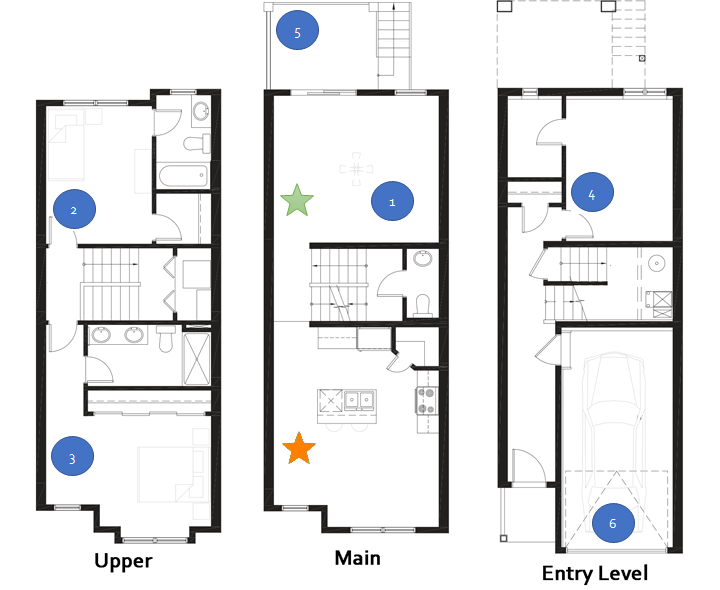
A brief description of the test locations is as follows:
- Location 1: Line of sight to router, approximately 2m distance
- Location 2: Non-line of sight to router, bedroom, one floor up
- Location 3: Non-line of sight to router, bedroom, one floor up, end of house
- Location 4: Non-line of sight to router, bedroom, one floor down
- Location 5: Non-line of sight to router, patio balcony, same level
- Location 6: Non-line of sight to router, attached garage, one floor down
Compared Hardware:
- ASUS ROG Strix GS-AX5400 (AX5400)
- ASUS ZenWiFi XD6 (Single) (AX5400)
- ASUS ZenWiFi XD6 (Double) (AX5400)
- EnGenius ESR580 (Single) (AC2200)
- EnGenius ESR580 (Double) (AC2200)
- D-Link DIR-X5460 (AX5400)
- TP-Link Archer AX6000 (AX6000)
- TP-Link Archer GX90 (AX6600)
- TP-Link Deco X90 (Single) (AX6600)
- TP-Link Deco X90 (Double) (AX6600)
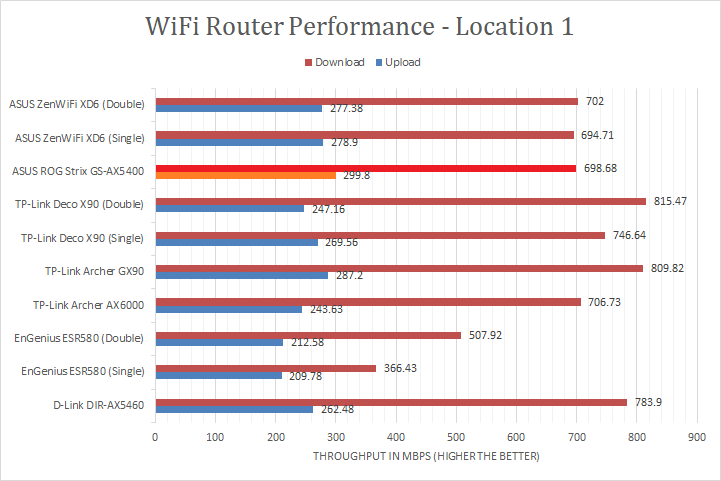
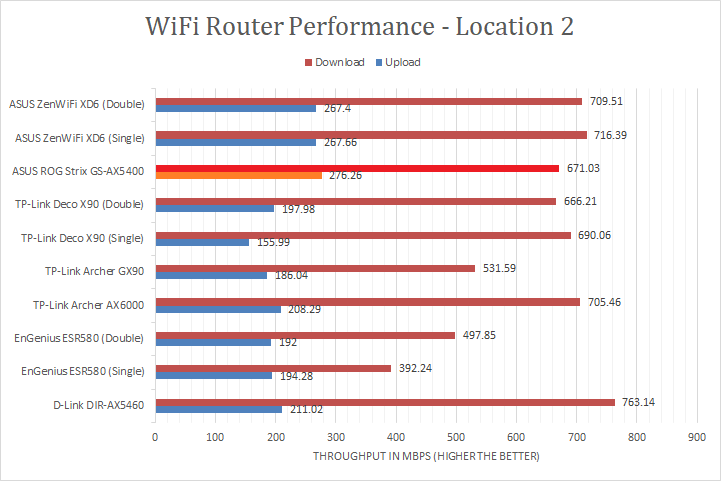
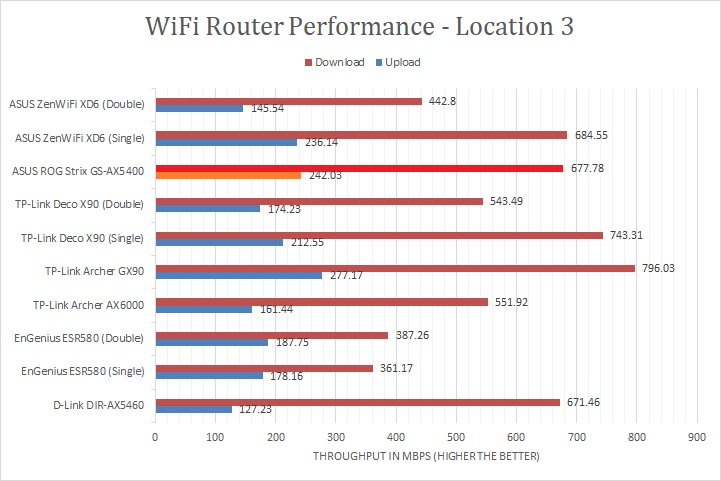

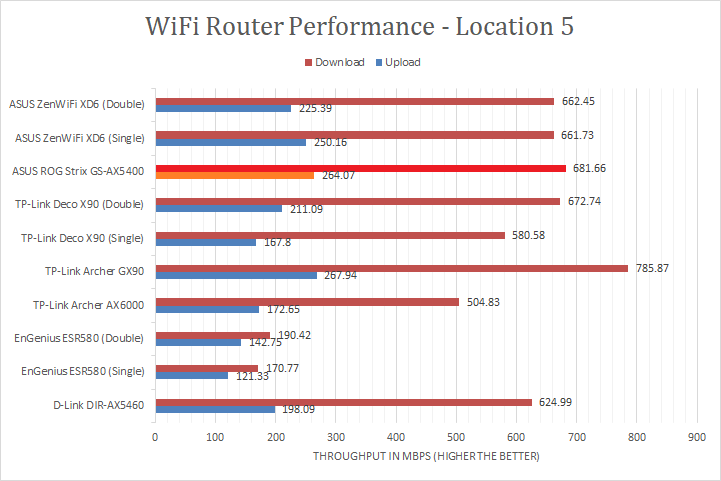
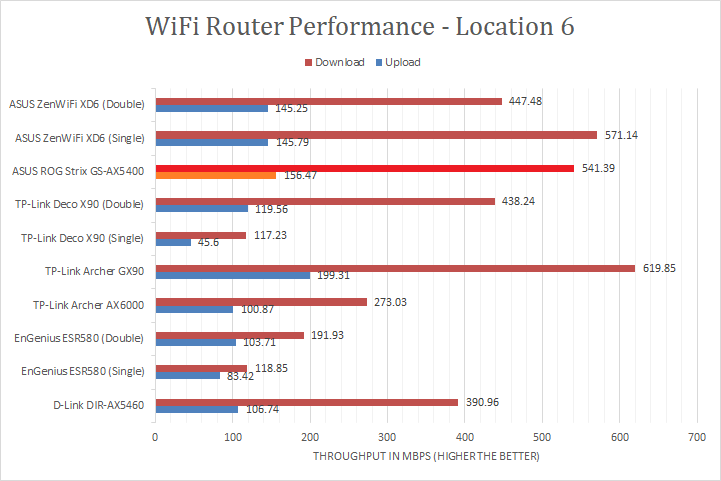
Location 1 is usually where routers demonstrate the maximum upload and download speed. This is part of the test design, as this is the only location with direct line-of-sight, not to mention a very close proximity. In this case, the ASUS ROG Strix GS-AX5400 had the fastest upload speed. Its download speed virtually tied with the ASUS ZenWiFi XD6, another AX5400 router, and about what was expected for its speed rating. Results from Locations 2 and 4, which are almost just above or below the router, respectively, showed the antenna array strength when the laptop is above or below even if it did not have direct line-of-sight. It seems the ROG Strix GS-AX5400's antenna array strength suffered only minimal losses when you are directly below than above it. As with Location 1, the GS-AX5400's upload speed was consistently strong in Locations 2 and 4 -- scoring first or second place -- in our charts. However, its download speed was a bit slower than the compared routers, including the company's own ZenWiFi XD6 and D-Link's DIR-X5460, both AX5400 routers.
Location 5 is outdoors and separated by a sliding glass door, but is generally still close to the router. Despite the horizontal distance, its speeds were close to that of Location 3. Speaking of which, Locations 3 and 6 are trickier regions, as they are the furthest away from the router and not directly above or below. Location 3 showed reasonably good upload and download speeds, with minimal losses compared to Location 1 and competitive against other routers on the list considering its speed class. Location 6 was the furthest distance from the router while being one floor below. Both upload and download slowed by a good margin compared to its peak, but the ASUS ROG Strix GS-AX5400 continued to perform consistently with a lower loss than routers like the DIR-X5460 and Archer AX6000. It came in third place for download and second place for upload.
Overall, the ASUS ROG Strix GS-AX5400 delivered good and consistent wireless throughput from short to long range. Its peak download numbers of 698.68Mbps, while never dipping below 541.39Mbps at any location, was great especially considering its AX5400 speed class. Although its peak speed was not the fastest, its minimum speed was far from the slowest, which shows a lot about its throughput consistency.
Page Index
1. Introduction, Packaging, Specifications
2. Physical Look - Hardware
3. Configuration and User Interface
4. Performance Tests
5. Conclusion





